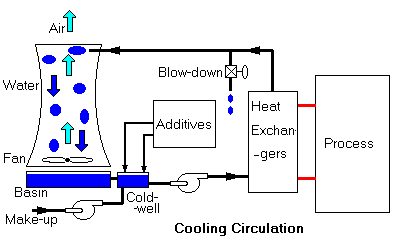MJMcCann Consulting

Cooling system dynamics and control.
While cooling systems are often treated as poor relations in an industrial plant, they are at the heart of operations and the whole plant can be dependent on a single cooling system.

The cooling water system is a lossy loop. Water starts in the BASIN at the bottom of the cooling tower. It flows into a smaller COLD-WELL into which additives go and from which water is PUMPed to go through HEAT EXCHANGERS. There will probably be many heat-exchangers in parallel or series paths of various lengths. Return water goes past a BLOW-DOWN valve which allows water to be taken out of system. Then on to top of tower to meet FANned rising AIR and loose heat by evaporation in falling down into the BASIN.
The use of evaporative cooling, as in a tower, causes build up of salt concentrations in the cooling water. Drawing off some of this briny water and making up the losses controls how salty it becomes. Such blow down, of course, also removes some of the chemical additives put in to inhibit corrosion and fouling.
Sometimes, when clean water is scare, desperate measures are taken using dirty water for circulation in the cooling system. It may keep the plant cool, but the problems of fouling and loss of thermal efficiency cost money.
The time scales for change are generally long and watching such processes is boring and may get insufficient attention.
Simulation Model with SCADA
McCann created a model of a complete cooling cycle system in which heat loads, atmospheric conditions, circulation rates and chemical inhibitor additions and attrition or depletion were included to show the dynamic behaviour of the build up of both the fouling and dissolved solids.
Associated with this work was the development of an instrument that could measure fouling by imitating the conditions in the main loops by means of a special instrument.
This was then linked to a programmable model of a proposed monitoring and control scheme (SCADA) based on using guidelines given by an expert to continuously monitor the process and make adjustments to the corrective feeds to keep the process working properly.
The model made it possible to check out the feasibility and behaviour of such an 'expert' system, looking after corrosion, fouling and bio problems, hour after hour, day after day.
The model was built using the McSimAPN simulation tool so that it could be readily experimented with, stopped and started during runs to make changes to both the model and its parameters and the control system. A further advanage was that the client could have the software as a free service and use it on any MS-Windows based PC without any installation issues... just put it in a folder and "Run" it.
Home/Index Page
About Dr McCann
Summary
Dr M.J.McCann
Training Courses
Bristol University
Contacting me
Contact in UK
Location USA
Philosophy
Software Tools
Fees
Confidentiality
Business & Commerce
TV Advertising
Drugs Competition
Housing Demand
Automobiles Demand
Wallcoverings Battle
Cash Flow
Human Resources
Project Management
Patent Analysis
Chemical Industry
Cooling Tower
Fermentation
Polymer Process
Heat exchange
Supercritical Fluid
Distributed parameter
Toxic gas allocation
Electrical
Control systems
Initiation systems
Ferrite Filters
Microstrip Antennas
Lightning
Production & Process
Automated manufacture
Crimp and Press
Glass making
Glass molding
Glass to metal seals
Heat exchanger
Helium Leak Testing
RF Soldering
Vacuum web coating
If you have a problem with the behaviour of a market sector, plant, process or item of equipment and would like to get a quantitative handle on it to improve yield or optimise performance, then contact me. I'm always ready to give a little time to discuss a new puzzle, in confidence, of course. We'll only worry about fees when there is some defined work. I can be flexible about how I work with you.
Top
POB 902,
Chadds Ford PA
19317 USA.
T: 1 302 654-2953
M: 1 302 377-1508 (Cell)
E: mjmccann@ieee.org
File: cooling.htm
 Applications
Applications